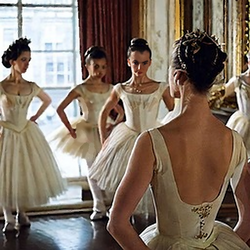Chrysean Ballet Company

Founded on 14.V.1715 AN, the Chrysean Ballet Company, which was affiliated from its inception with the Benacian Philharmonic Orchestra, was formed in response to the growing popularity of ballet in high society under the patronage of the ruler of Chryse, Ayesha al-Osman.
Origins
The Benacian tradition of ballet originated in the highly choreographed performance dances conducted by the retinues of pages of the Dirâsat-an-Nûr in Raynor's Keep. In earlier times the dances of the castrati were especially admired by the members of the court, leading to a fashion for dancing troupes in the retinues of noble households in Brookshire and Goldshire.
Over time the castrati, who lost a large measure of their prestige during the campaigns of mass-gelding undertaken against the Froyalanish by Steward Liv Dravot, were joined by boys and girls of no-less pleasing aspect albeit less costly preparation. They would indeed be eventually supplanted altogether, although purists and aesthetes would continue to bemoan the change.
The years after Kalirion Fracture were a dark one for the old dancing troupes. With the disruption of the old forms of patronage, many troupes disbanded or were obliged to transform into touring companies, performing "popular" pieces in theatres, dance halls, and tavern courtyards. The more unfortunate outfits degenerated to the point where they were scarcely distinguishable from the bundies and octalunes whose disgraceful company they were obliged to keep.
The art form would find a measure of preservation in Ransenar following the fracture, as the ostensibly democratic government there was keen to be perceived as promoting the arts, including dance, as part of the new state's role in the preservation of the cultural heritage inherited from Goldshire.
With the accession of Ransenar to the Benacian Union in 1711 AN, the surviving troupes of touring dancers were, as bodies of professional entertainers, obliged to subordinate themselves to the Guild of the Lotus in return for chartered status and the requisite licences to perform. Dancing girls were indeed already a feature of the flower streets within the paradise districts of Merensk and Ardashirshahr and the establishment of theatre companies proved to be a logical progression.
The alternative to subordination to the guild was to obtain direct patronage, a role filled by corporations such as the Honourable Company and governmental authorities following the diminishment of the old nobility, and one of the foremost patrons of the arts to emerge following the Second Elwynnese Civil War had been Ayesha al-Osman, the High Commissioner of the Free City of Chryse since it's capture in 1690 AN.
The motivations of the High Were not altogether philanthropic. As ruler of Chryse, the capital of the Benacian Union, she was obliged to host, at intervals of roughly ever four years, the vast delegations of the Congress of Chryse, the ruling body of the Union-State, which brought together the victors of the civil war. In addition to recieving these recurring guests, Chryse was also obliged to host the permanent establishments of the High Presidium of the Benacian Union and the Chamber of Guilds and Corporations, along with a substantial garrison of the Benacian Union Defence Force. Amongst the obligations placed upon a host was the duty to keep guests at all times entertained, and Ayesha was in no-way unstinting in this regard - keeping up a succession of balls and other society events throughout the year.
To maintain the tempo of what was becoming known as the season in Chryse, especially during the sessions of the Congress, required the existence of a corps of entertainers and performers retained in the city on a permanent basis. It would be from this requirement then that the motivation for the creation of a retained company of professional dancers would receive its initial impetus.